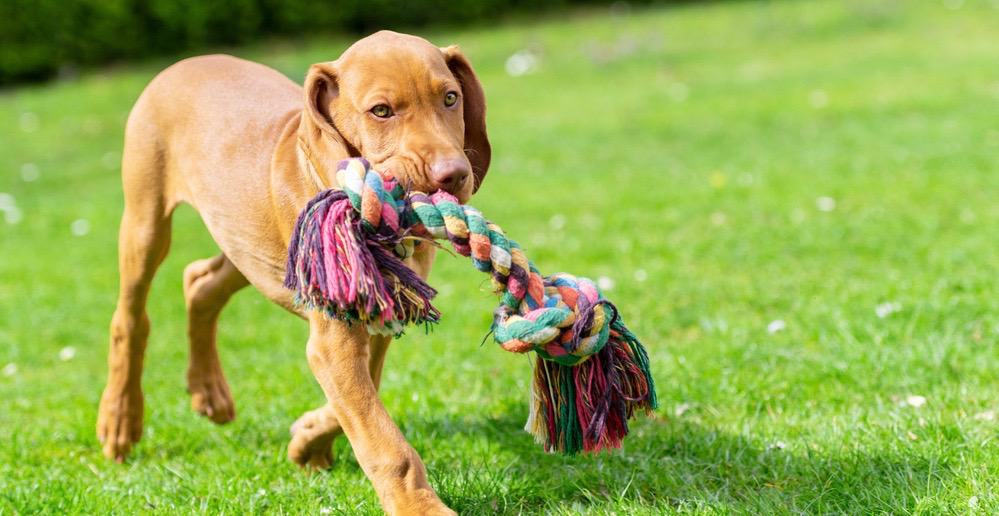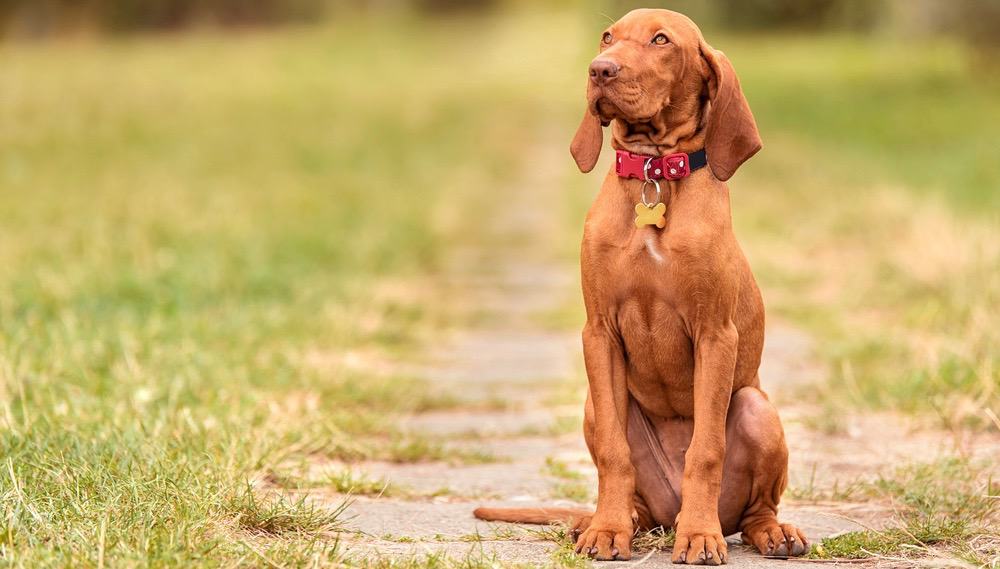Vizsla Growth Chart & Weight Chart – When Do Vizslas Stop Growing
The Vizsla is a beautiful lean and sleek dog from Hungary, bred for hunting as pointers and retrievers. Due to this heritage, small animals like rodents, birds, snakes, and reptiles are in danger of being hunted down if there’s a Vizsla in the vicinity.
The other side of this story is that these hunting dogs used to stay close to their hunter owners while out on a hunting trip and they still have this habit today. They like to stick close to their owners and follow them around.
Vizslas are active dogs and need exercise every day. They are happiest when they have a job to do, like being out for a walk with you, or being trained to participate in dog sports. They also make great therapy dogs.
Vizslas are vocal dogs and your Vizsla will ‘’tell’’ you long stories if you talk to him. These dogs love company and are not happy being left alone.
They need physical and mental stimulation otherwise they become bored and destructive. With loving attention and enough ample exercise, this gentle dog will be a great family member.
You can learn from our Vizsla growth chart how fast your puppy will grow up.
When Do Vizslas Stop Growing

For the most part, Vizslas grow until they reach one year of age. They normally reach their full height by this stage.
These dogs grow slowly and it will take another six months for your dog to fill out completely, although some owners report that their dogs kept on filling out until around two years of age.
When your female Vizsla stops growing, she will have reached a height of 21 – 23 inches and she will weigh between 45 and 55 pounds. If you have a male dog, he will weigh around 55 – 66 pounds and he’ll stand 22 – 24 inches high.
Vizsla Weight Chart
Like other dog breeds, the female Vizsla starts out at a lower weight than the males and when they are fully grown, they weigh about 10 pounds less than their male friends.
When they are three weeks old, male Vizsla puppies weigh around 17.2 pounds and the females weigh around 16.5 pounds. Two weeks later, the males have put on another 2.4 pounds and the females have added a pound and a half.
When the dogs reach four months, the males weigh around 23 pounds and the females weigh around 20.5 pounds.
There can be a considerable difference between bigger male dogs and smaller male dogs. By one year of age, the smaller male dogs will weigh around 19 kg and the bigger dogs will weigh around 28 kg, which is quite a big difference.
Both the males and the females keep on gaining weight at a steady pace throughout the following months. By 24 weeks, the males weigh around 36 pounds and the females weigh two pounds less at around 34.2 pounds.
After the one-year mark, both males and females don’t put on much more weight.
Don’t worry if your dog doesn’t put on weight exactly according to the Vizsla weight chart below. All dogs are different and the weights represent averages. If your dog weighs in at a little under or over these weights, it’s nothing to worry about.
Vizsla Puppy Weight Chart
| Age | Weight (kg) | Weight (lbs) |
|---|---|---|
| 3 Months | 8 - 11 kg | 17.6 - 24.3 lbs |
| 4 Months | 10.5 - 14.7 kg | 23.1 - 32.4 lbs |
| 5 Months | 13 kg - 17.6 kg | 28.6 - 38.8 lbs |
| 6 Months | 14.7 - 20.5 kg | 32.5 - 45.2 lbs |
| 7 months | 16.3 kg - 22.5 kg | 35.9 - 49.6 lbs |
| 8 months | 17.2 kg - 24.4 kg | 37.9 - 53.7 lbs |
| 9 months | 18 - 25.8 kg | 39.6 - 56.8 lbs |
| 10 months | 18.7 kg - 26.6 kg | 41.2 - 58.6 lbs |
| 11 months | 19.1 kg - 27.5 | 42.1 - 60.6 lbs |
| 12 months | 19.4 - 28 kg | 42.8 - 61.7 lbs |
Vizsla Growth Chart – What To Expect

Birth – 2 Weeks
Like other puppies, the Vizslas are born blind, deaf and without teeth. They weigh between 0.5 and 0.85 pounds. The puppies can’t walk and spend their time nursing and sleeping.
At about 2 weeks, a lot of things start happening. The puppies can open their eyes and they start walking around. In this time, their ears open up and they become more aware of their surroundings and each other.
3 Weeks – 12 Weeks
At this stage, the puppies grow rapidly. They learn what their status is in the litter and about their biting instinct. At 6 to 7 weeks, the puppies are playing with litter mates and learning what it means to be part of a litter.
Between 7 – 8 weeks is an important stage for puppies when they learn important lessons from their mother. They shouldn’t be taken away from their mother before 8 weeks of age.
Around this time, puppies should get their first vaccinations and deworming medication.
Puppies start bonding with humans when they are about 8-9 weeks old. Owners can now teach their puppies manners and basic commands. At this stage, they need a lot of socialization.
Another important part of this development stage is the first fear stage that happens between 8 and 12 weeks. Your puppy may suddenly be afraid of things, people and situations that he was not afraid of before. It’s important to socialize him and make it clear that there’s nothing to fear.
4 Months – 9 Months
At four months, your puppy can respond to basic commands like “Come.” It’s a good idea to take your puppy for obedience classes when he’s around five months old, so he can learn to become a well-behaved family member.
When he is six months old, he will be able to respond to a wider variety of basic commands.

Exposure to a variety of environments stays important. You must continue to socialize and train your puppy if you want a dog that knows how to behave with other dogs and people, especially if you plan to take your dog out to public places.
Keep introducing your dog to new places and different situations so he won’t react fearfully or aggressively in unfamiliar situations in the future.
10 Months – 18 Month
Vizslas become sexually mature when they are nine months old. When they are a year old, they have reached their adult size, although most of them keep on filling out until they are 18 months old. This is also the time to have your dog spayed or neutered.
Keep training and socializing your dog. Take him with you on errands so he gets used to different sounds and environments. Up to the age of 18 months, your dog should not exercise vigorously as his bones and joints are still developing.
Adult
Vizslas reach full adulthood at around 18 months when they also stop growing. At this stage, your dog’s bones and joints are fully developed and you can now take him with you jogging or for agility activities.
At 18 months, your dog is ready to be weaned off puppy food, so give your Vizsla a high-quality dog food that is specially formulated for medium-sized dogs and feed him three to four cups twice a day.
If you were conscientious about training and socializing, you should have an adult dog that is a pleasure to have around.
Factors That Affect Vizsla Puppy Growth
Genetics
Genetics plays a very big part in deciding the size of most dogs. The parents of your dog as well as their parents will determine how big your dog will become.
If your Vizsla’s lineage is that of large hunting Vizslas, the chances are very good that your dog will also be large. On the other hand, if your dog’s parents were on the small side, and they came from small parents, your dog will most probably also be small.
Nutrition
The other factor that will influence your puppy’s growth, is the food that you feed him. Make sure that you give your puppy high-quality kibble specially formulated for puppies.
Kibble for puppies is formulated to provide the nutrients small dogs need to grow optimally. Puppy formulas are high in protein, fat, vitamins, and minerals and are higher in calories than kibble for adult dogs.

Monitor your puppy to make sure that the kibble you give him agrees with him. Change the kibble if he refuses to eat or develops diarrhea.
Physical Activity & Health
Vizslas were bred to hunt, so they are high-energy dogs that need a lot of exercise to be happy. However, this does not apply to Vizsla puppies.
The bones and joints of Vizslas develop until they are eighteen months to two years old. Before this age, too much exercise can damage their bones and joints irreversibly, causing them unnecessary suffering later in life.
The golden rule is a maximum of five minutes exercise for every month of age. So when your dog is two months old, it should only exercise 10 minutes a day. This is very important. Don’t walk your dog longer than recommended otherwise it might develop hip and elbow dysplasia later on.
How Long Are Vizslas Pregnant?
A healthy female dog will be pregnant between 55 and 68 days, with most being pregnant for 63 days. However, don’t be surprised if your Vizsla is pregnant for 70 days, it happens!
You won’t know that your dog is pregnant during the first month, but you’ll start noticing some changes in her from the second month. For example, she will begin to eat more and you might notice a slight weight gain. She may also start urinating more often.
You will see clear indications that your dog is pregnant towards the end of the second month of pregnancy, when her nipples will be very swollen and her tummy has visibly increased in size.
How Many Puppies Do Vizslas Have?
A Vizsla typically has six to seven pups, but they are known to have the odd bigger-sized litter. There is no way to know beforehand how many puppies a female Vizsla will have.

Even if the mother comes from a large litter, there is no guarantee that she will give birth to a large litter.
Vizslas are healthy and don’t have birthing issues, so not many puppies are lost to stillbirths or other complications.
What If My Vizsla Is Not the Right Weight
Vizslas tend to be slim dogs, so you might be worried that your dog is too skinny. However, keep in mind that his breed is supposed to be muscular and lean.
To know if your dog is the right weight, look at him from the top and the side. You should not be able to see his ribs. If you do, your dog is too skinny.
Also, run your hands over your dog’s body – you should be able to feel your dog’s ribs – if you don’t, then your dog is overweight. If this is the case, you need to give your dog less food, make sure there are no treats between meals, and take him out for exercise.
If you think your dog is underweight although it’s enjoying a healthy diet, you may have to take it to the vet for a check-up.
What Is The Life Expectancy Of Vizslas?
Vizslas are a strong and robust breed that have a relatively long lifespan. They live for 11 – 15 years, which is a good lifespan for dogs.
If you want to be sure that the dog you buy will live a long, healthy life, make sure you buy from a reputable breeder who can provide certification that both parents were cleared of hip dysplasia, hypothyroidism, and eye diseases.
Do your part by providing your dog with a healthy, balanced diet and adequate daily exercise.
How Much Does It Cost To Own A Vizsla?
A Vizsla costs between $1,000 and $2,200 depending on whether the dog is registered to a kennel club and how well it physically compares to the breed standard. The average price is $1,100.
In the first year, your dog will cost you around $3,985, but in the following years the cost should be only about $1,455 per year. Over your dog’s lifetime, you can expect him to cost you around $20,000 – $22,900.

This figure includes the basics you need for your dog, including food, treats, licenses, veterinarian expenses, training costs, grooming costs, and a microchip.
Expenses like spaying or neutering your dog or housing him in a kennel, hiring a dog walker, and pet insurance are not included.
Vizsla Genetics and Common Health Problems
Vizslas are generally a healthy and robust dog breed, but some dogs can develop hip problems, thyroid issues, or certain canine eye conditions.
As mentioned earlier, this breed can develop hip dysplasia when they are older. Young dogs should not be encouraged to exercise vigorously, so their joints and bones have a chance to develop properly.
Epilepsy is fairly common among dogs and the Vizsla can also develop the condition.
Other health conditions that may affect this breed include, hypothyroidism, cancer, and PRA, a degenerative eye disorder that can lead to blindness.
These health conditions are not particular to Vizslas, but they can fall victim to one or more of them, so you need to beware of it.






